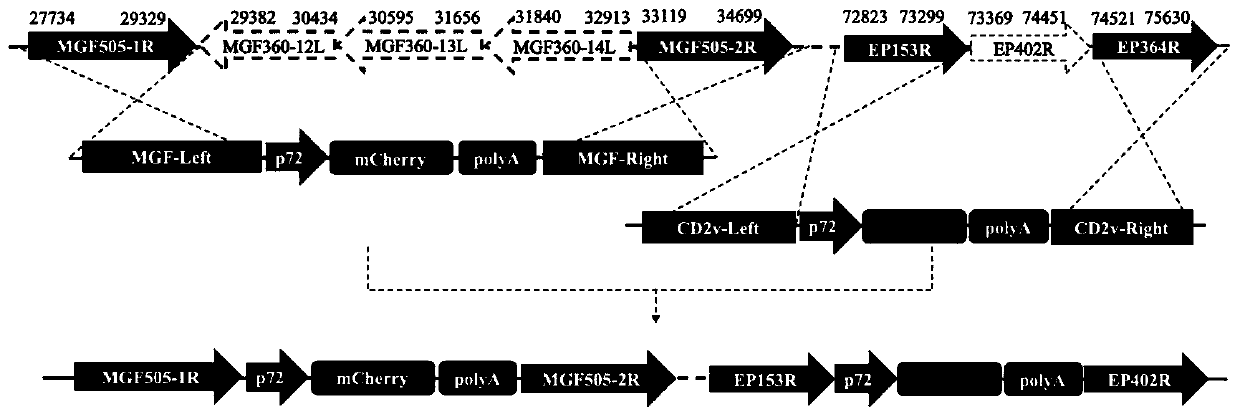Four-gene-deletion weak-toxin strain for African swine fever viruses and application of four-gene-deletion weak-toxin strain
A technology of African swine fever virus and gene deletion, applied in the field of bioengineering, can solve the problems of dose-dependent side effects, extremely severe and complicated prevention and control situation, and reduce the actual use value of vaccines, etc.
- Summary
- Abstract
- Description
- Claims
- Application Information
AI Technical Summary
Problems solved by technology
Method used
Image
Examples
Embodiment 1
[0037] Example 1 Construction and purification identification of recombinant viruses SY18ΔC and SY18ΔMC4
[0038] 1. Materials and Methods
[0039] 1.1 Biosafety license and African swine fever laboratory activity license
[0040] The Military Veterinary Research Institute has approved the Biosafety Committee of the Military Veterinary Research Institute, the Experimental Animal Ethics Committee, the Biosafety Committee of the Military Medical Research Institute, the National The Army Experimental Animal Ethics Committee and the Biosafety Committee of the Academy of Military Sciences reported it step by step, and obtained the permission from the Health Bureau of the Logistics Support Department of the Military Commission to carry out research on highly pathogenic ASFV pathogens and animals, and it has been filed with the Ministry of Agriculture and Rural Affairs, which meets the requirements of the national biosafety level. .
[0041] 1.2 Cells and viruses
[0042] Primary ...
Embodiment 2
[0061] Example 2 Determination of Growth Characteristics of Recombinant Viruses SY18ΔC and SY18ΔMC4 in PAM Cells
[0062] 1. Determination of virus growth curve
[0063] Spread the primary porcine PAM cells into a 6-well plate, grow into a monolayer, inoculate with 0.1moi virus solution, incubate at 37°C for 2h, and harvest at 0h, 6h, 12h, 18h, 24h, 30h, 36h, and 48h after infection The virus was amplified, frozen and thawed three times, and then subpackaged by high-speed centrifugation. The titers of the virus were measured respectively, and the growth curves of the wild virus and the gene knockout virus were drawn.
[0064] 2. Virus titer titration
[0065] Dilute the above-mentioned recombinant virus solution according to a 10-fold gradient, infect the porcine primary PAM cells that have been spread in a 96-well plate to form a monolayer, fix the infected cells with 4% paraformaldehyde solution 72 hours after infection, and add P30 diluted at an appropriate concentration. ...
Embodiment 3
[0068] Example 3 Safety Evaluation Experiment of Recombinant Viruses SY18ΔC and SY18ΔMC4
[0069] In order to detect whether the above two gene knockout viruses have no pathogenicity at all, in this experiment, at first, different infection doses (10 3 、10 4 、10 5 TCID 50 ) recombinant virus to evaluate the safety of piglets. In this experiment, 30 African swine fever antigen antibody-negative healthy Sanyuan piglets were divided into 6 groups. After immunization, the daily feed intake, body weight and body temperature were measured, and peripheral blood and saliva were collected every 5 days. The blood content of ASFV virus was measured by fluorescent quantitative PCR method, and the observation was terminated after 60 days. The experimental scheme is shown in Table 1.
[0070] Table 1 Safety Evaluation
[0071]
[0072] result:
[0073] Through the safety evaluation, it was found that the SY18ΔC strain was inoculated by intramuscular injection for 10 3 TCID 50 Th...
PUM
| Property | Measurement | Unit |
|---|---|---|
| diameter | aaaaa | aaaaa |
Abstract
Description
Claims
Application Information
 Login to View More
Login to View More - R&D
- Intellectual Property
- Life Sciences
- Materials
- Tech Scout
- Unparalleled Data Quality
- Higher Quality Content
- 60% Fewer Hallucinations
Browse by: Latest US Patents, China's latest patents, Technical Efficacy Thesaurus, Application Domain, Technology Topic, Popular Technical Reports.
© 2025 PatSnap. All rights reserved.Legal|Privacy policy|Modern Slavery Act Transparency Statement|Sitemap|About US| Contact US: help@patsnap.com



